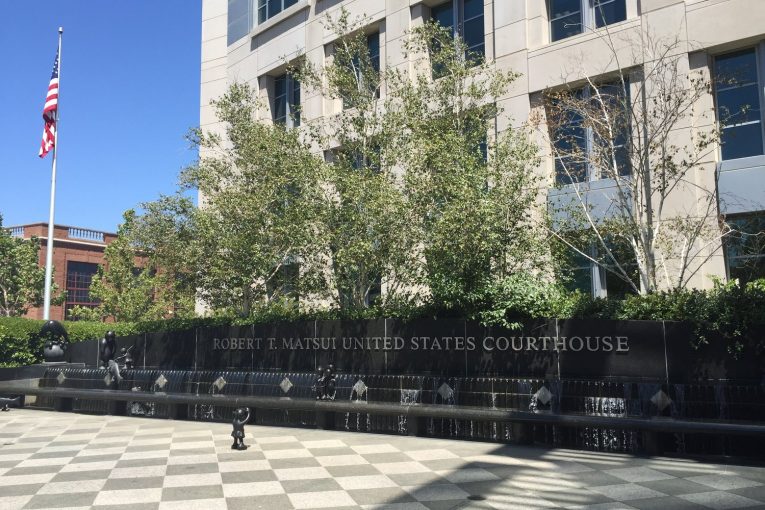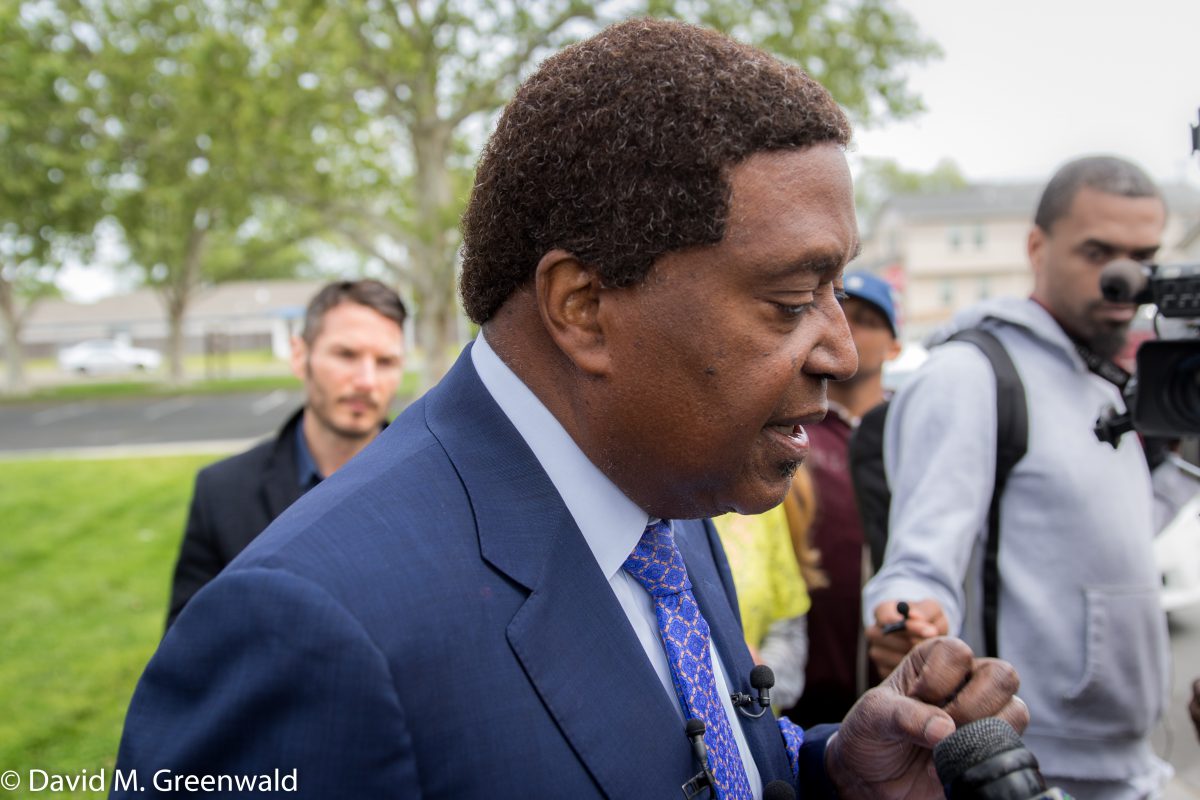

By Crescenzo Vellucci
Vanguard Capitol Bureau
SACRAMENTO – Civil rights attorney John Burris didn’t bother to mince words in his closing arguments for the family of a 16-year-old special needs teen killed in a hail of gunfire by Stockton police in 2010, a day before the Black youth’s birthday.
An officer “panicked” and “lost his wits,” said Burris. Officers used 29 shots to kill alleged carjacker James Rivera Jr. nine years ago, July 22, 2010 – his parents (Dionne Smith-Downs and James Rivera Sr.) are suing the officers in federal court here.
The civil rights trial of police officers is seldom seen – most cases of this type settle or are tossed by the courts. It began last Monday in U.S. District Court here and went to the eight-person jury late Friday, after nearly 50 people packed the federal courtroom.
The trial centers around whether officers were in real danger, and reasonable fear for their lives before they fired into a darkened residence garage where a stolen van driven by Rivera was chased, broad-sided by Stockton police and shoved into a garage of a triplex.
Greg Dunn, one of the two officers charged with using excessive force, said he was in danger. Other officers and bystanders disagreed. Dunn, and co-defendant Eric Azarvand said they thought Rivera had weapon, but the teenager was not armed.
Witnesses, including at least one police officer, said they didn’t see the van, wedged in the garage area of the triplex, appreciably move toward Dunn, and wasn’t a threat to Dunn, who was terminated from the Stockton police force for what SPD claims are unrelated reasons.
Plaintiff and defendant police practices experts disagreed with each other – one expert emphatically maintained Stockton police officers made a “tactical error” by shooting and killing Rivera, but  another applauded the officers’ actions.
another applauded the officers’ actions.
Burris focused on Dunn as the instigator of the shooting and death of Rivera.
“You can’t create conflict. You can’t place yourself in danger and then shoot your way out. It wasn’t ramming. The van was rocking. That’s not the basis to shoot. (And) shooting blindly 13 times (Dunn emptied his clip) into a space that he couldn’t see into…isn’t there some responsibility? asked Burris of the jury.
“You can’t shoot because you panic and are afraid. You can’t execute someone,” added Burris, who criticized Dunn for not giving lawful verbal notice to Rivera that he would use force if Rivera – who may have been unconscious or injured from crashed into the residence – didn’t respond.
There was no standoff, Burris reminded the jury. Dunn hit Rivera’s stolen van twice, it crashed into the garage area of the triplex and about 15 seconds later Rivera died after a rain of bullets.
“No one said they would shoot. They only said to get out. There was no warning of force. Within seconds (of the warning) you heard shots…it shocks the conscience. Dunn might have been fearful but it’s not what a reasonable officer would have done,” said Burris.
“They chose to not take some time. They chose instead to take a boy’s life. James was surrounded and outnumbered. There was time to move back, he had time to move,” said Burris, laying the blame more on Dunn than any other officer.
“Officers shot because of what Dunn did, and only because he said he was trapped…that’s the basis for them to all shoot and kill,” charged Burris.
Dunn, he said, only “perceived” he was in danger, but it was an “unreasonable fear.” Three officers – Dunn, Azarvand and a sheriff’s deputy – fired 29 shots. Six shots went into the back of Rivera, and two in the side, one in the back of the neck.
“If 29 shots doesn’t shock your conscience (a legal requirement for the plaintiffs win), nothing will. With proper warnings, (James) may have surrendered, but other officers responded to Dunn’s fear. Dunn panicked. He lost his wits. Firing of 29 shots is excessive force. Period,” Burris closed.
Nisenbaum, in his closing argument, used the words of the defense team’s own witnesses to show “this is evidence of a bad shoot. One shot was too much. This was unreasonable.
Nisenbaum seized on the words of Craig Fries, founder of Precision Simulation, a forensic firm in Grass Valley, and a defense witness who provided a dramatic, animated reconstruction of the physical evidence at the scene – for the most part based on statements of Dunn and Azarvand.
“There is no evidence of significant (van) movement. Mr. Fries said zero to 15 inches, not five feet. Not enough to take a life or the use of lethal force,” he said, knowing that police usually need to claim and show they feared for their life to make the use of force legal.
For Dunn and Azarvand, that meant the threat of the van backing up and injuring them.
“But,” said Nisenbaum, “bumping is not ramming,” explaining to the jury that “rocking” is not moving and that the “suspect is not going to put it in reverse…because it was stuck in the garage.”
He used the testimony of another defense witness, Ronald Miller, a SWAT team instructor and the Plaintiff’s police procedures expert Roger Clark to show “this was a panic shooting. (Dunn) lost self-control.”
“Miller and Clark agreed that if the van only moved slightly it was not enough to use lethal force. It should not have happened. The intervention was successful. The van was stopped. No shots were required. Each shot here more gratuitous,” he said.
“Officer Dunn said he was concerned (about the van hitting him). He shouldn’t shoot somebody for that. He never had to shoot the boy at all. He should be in jail. They knew he was 16,” added Nisenbaum.
His arguments hit upon the same theme over and over again. That there was no need to shoot, the van was pinned in the residence, there were alternatives to killing Rivera other than shooting and Rivera was not a threat.
“You can’t take a life on that basis,” said Nisenbaum, who said that the shooting officers were “not on a clock…they knew (other) officers were coming. They had time to deliberate. They did not. They were deliberately indifferent. It was malicious.”
Bruce Kilday told the jury that even for the defense, “this is has been a challenging case. A lawsuit can’t bring their (Dionne Smith-Downs and James Rivera Sr.) son back. No one is happy about the outcome.”
He went on to list the “undisputed facts,” including that Rivera escaped from jail, reportedly burglarized a home, and participated in an armed car checking the day before.
He discounted the testimony of local residents, even the two neighbors who lived in the same triplex as the one that took the direct hit from the van when Dunn rear-ended it.
“Their central claim that the shooting was not reasonable, that the van was immobilized, the suspect trapped and that called for tactical repositioning is contrary to physical evidence,” he said, repeating that defense mantra that the van moved forward and backward and was a threat to the life of Dunn, who was caught in a “v” between his car, his car door and another car bumped to the left by the van when it plowed into the building.
Kilday argued that no one can now use “20/20 hindsight,” and stated that the two defendants believed what was “objectively reasonable at that time,” including that felt the “driver was not contained” and that to believe otherwise would be “foolhardy” by the defendants on the scene.
“The threat had not come to a conclusion; there was no time for decompressing,” as Clark, the plaintiff expert witness recommended. “Tactical repositioning would not have worked,” noted Kilday.
“(Expert witness) Clark said he was agnostic about movement of van….Dunn didn’t have luxury of being agnostic,” said Kilday, and asked the jury to find his officers not guilty.
Kilday saved to the end an attack on Rivera Jr. parents, Smith-Downs and Rivera Sr. Because the claim is for damages to them, and their loss of their son, Kilday made his points to minimize their importance to their son.
It wasn’t pretty.
“I don’t mean to add to the family’s (grief). Smith-Downs didn’t know he was a probation; I’m not trying to insult her. She didn’t know her son’s friends,” he added, while acknowledging with other children to take care of she had a “full commitment and a huge responsibility.”
He said that Rivera Sr., in prison most of the junior Rivera’s life, “wanted to have a relationship but couldn’t. Wanting to be a parent does not show a familiar relationship,” although Rivera said in previous testimony that he called and wrote his son often, sent him money and gifts and had visits.
Before the final arguments, the City of Stockton called Fries, the crime scene reconstruction analyst.
While noting that it’s “impossible to preserve the crime scene,” Fries did say that his 3D presentation “maintains fidelity” of what happened that day when the young Rivera was killed in a storm of bullets.
Admitting it was not an “exact science, Fries played a 3D video for the jury that used police radio communications and information gleaned from the crime scene, including 3D scans produced by CA Dept. of Justice.
Although the 3D reenactment was intense, and showed Dunn in trouble, Fries confessed under cross examination that the vehicle may have moved 15 inches, or as little as zero inches, far from Dunn’s suggestion the van was ramming him, and the vehicle move up to five feet.
Nisenbaum, on cross for the plaintiffs, was able to get Fries to admit that he “relied” largely on officers’ statements, like Dunn. “That’s what they said,” said Fries.
But Nisenbaum shot back, “Just because the van was rocking doesn’t mean it was moving, right? And mud splatters only means the tires are moving (not necessarily the van as Dunn contended).”

The facts of this police shooting, as described in the article, are horrific. But I’m not sure what the relevance is of describing the victim as a “special needs” teen, whatever that means. It would seem to have had no bearing on the officers’ culpability or the harm suffered by surviving family members.
Makes it sound more ‘victim-y’, and makes the perps sound more-er badder — “He’s a special needs kid, let’s get ‘im”
Think you nailed that, Alan…
Relevance is diminished capacity impacts response to police orders.
And the officers knew that, how? Ex post facto? Monday morning quarterbacking?
Am thinking things go down in “real time”… saying that, am NOT saying that there was justification… but, I was not there, in “real time”… so, I don’t know… but it appears the author is writing as if he was an eyewitness…